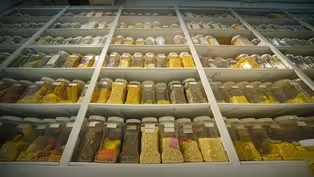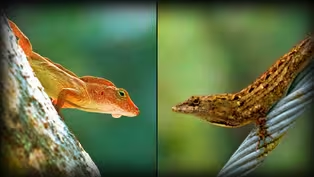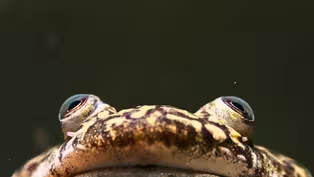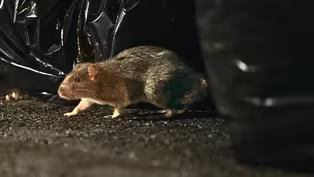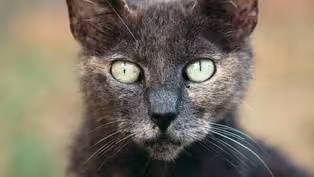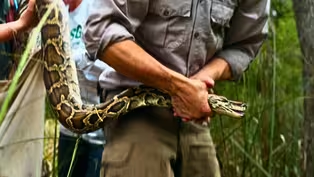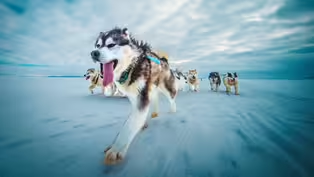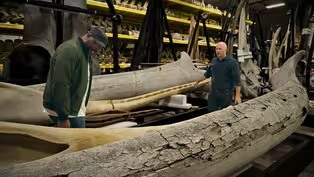
How Dogs Are Shaping The Future Of Medicine
Special | 12m 43sVideo has Closed Captions
Observe the rich diversity of dog breeds, shaped by genes and human intervention.
The Westminster Kennel Club played a vital role in preserving and promoting the rich diversity of dog breeds – resulting directly from the hand of human intervention. Shane Campbell-Staton meets these posh pooches and unlocks the secrets of the canine code. We unravel how genes and selective breeding shape these remarkable creatures, with some mutations linking dogs and humans more than expected.
Problems playing video? | Closed Captioning Feedback
Problems playing video? | Closed Captioning Feedback

How Dogs Are Shaping The Future Of Medicine
Special | 12m 43sVideo has Closed Captions
The Westminster Kennel Club played a vital role in preserving and promoting the rich diversity of dog breeds – resulting directly from the hand of human intervention. Shane Campbell-Staton meets these posh pooches and unlocks the secrets of the canine code. We unravel how genes and selective breeding shape these remarkable creatures, with some mutations linking dogs and humans more than expected.
Problems playing video? | Closed Captioning Feedback
How to Watch Human Footprint
Human Footprint is available to stream on pbs.org and the free PBS App, available on iPhone, Apple TV, Android TV, Android smartphones, Amazon Fire TV, Amazon Fire Tablet, Roku, Samsung Smart TV, and Vizio.
Buy Now
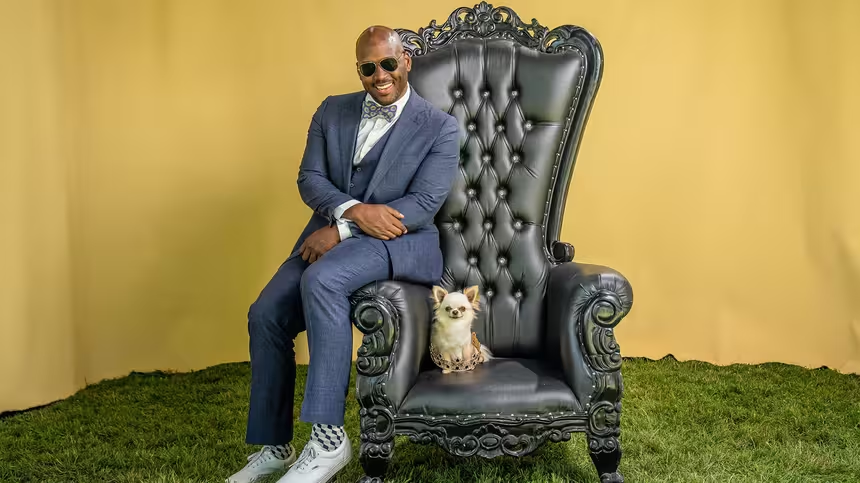
Surprising Moments from Human Footprint
Do you think you know what it means to be human? In Human Footprint, Biologist Shane Campbell-Staton asks us all to think again. As he discovers, the story of our impact on the world around us is more complicated — and much more surprising — than you might realize.Providing Support for PBS.org
Learn Moreabout PBS online sponsorshipMore from This Collection
Human Footprint is a show that delves into the impact of humans on the planet. Join Shane as he travels from farms to restaurants, from high-tech labs to street markets, and from forests to cities to uncover the consequences of our unique history. Are you ready to explore our past, present, and future as a species?
Video has Closed Captions
Watch the rise of a productive crop that has managed to replace itself, but at what cost? (11m 24s)
The Watery Price Of Golf Courses & Lawns
Video has Closed Captions
The cultural and resource costs for manicured lawns and golf courses are quite shocking. (11m 29s)
We Brought This Fish To America. Now We Can't Get Rid Of It
Video has Closed Captions
Expose Asian carp for disrupting native fish species and shrinking their populations. (10m 39s)
Why Are These Urban Lizards Evolving in Overdrive?
Video has Closed Captions
Examine city-dwelling anoles with remarkable evolutionary changes. (10m 33s)
How An Ancient Ocean Shaped Us History
Video has Closed Captions
Learn how millions of years of deposits shaped the events of Black American history. (16m 54s)
Video has Closed Captions
What happens when frogs become indispensable? (8m 59s)
Video has Closed Captions
When it comes to NYC, the rat is the undisputed king! (13m 26s)
Your Cat’s Secret Life (as a Deadly Predator)
Video has Closed Captions
Cats have been winning the hearts of humans for years....but can devastate ecosystems. (10m 40s)
Singapore: Designing a Megacity in Harmony with Nature
Video has Closed Captions
Green spaces aren't just an afterthought here - they're mandatory! (13m 24s)
How Giant Pythons Became Florida’s Biggest Invasive Species
Video has Closed Captions
Ever heard of the phrase "when pet pythons outgrow their owners"? (13m 24s)
Sled Dogs: The Most Extreme Distance Athletes on Earth
Video has Closed Captions
In the Arctic, it's not just about muscle power, but brainpower too. (15m 17s)
Secrets of the World’s Only Whale Warehouse
Video has Closed Captions
Uncover the history of whaling and its impact on our oceans. (9m 58s)
Providing Support for PBS.org
Learn Moreabout PBS online sponsorshipThis is my best friend Tatanka.
I love this guy.
He’s not just like family, he is family.
What we have feels pretty special, but it’s certainly not unique.
To live in our world, dogs have had to reinvent themselves time and time again.
Wherever we live, you’ll find dogs living alongside us – whether they’re battling it out on the streets or helping us survive in the harshest environments.
Then, there are the dogs that have it all.
Shaggy, short-haired, hairless, tiny, sensible, and massive.
A kaleidoscope of colors.
Hundreds of distinct dog breeds, meticulously curated through a human’s discerning eye.
People have strong feelings about purebred dogs.
But you might be surprised to learn that they - and the genetic history they carry in their DNA - are actually giving back to us in a way we’d never expect.
I’m Shane Campbell-Staton, and this is Human Footprint.
Dog breeding has been a part of the human experience for a long time.
By the time the Egyptian pyramids were built, we had already shaped dogs into a handful of distinct breeds, each one specialized for a specific task.
If you've ever seen these dogs really do what they're bred to do, it's an incredible sight.
He’s fast and elusive, intelligent and willing.
Loyalty and emotion to his job are common placement.
This creature in their world, this is my best me, this is what I do.
But these ancient breeds are just a tiny fraction of what dog diversity has become in the last 150 years.
I've never been to Westminster.
Is Westminster essentially the Super Bowl of dog showing?
It is serious competition.
Okay.
It is serious competition.
When you're in the ring.
Okay, I’ve died and gone to heaven.
Bouviers, bulldogs, Spanish water dogs, dachshunds and chihuahuas, borzois, Chinese crested, basenjis, pugs, Scottish deerhounds and toy poodles!
And these are no ordinary dogs.
These are the best of the best.
For more than a century, the world's most remarkable purebred dogs have descended on New York each year to go for glory in the Olympics of canine competitions.
Alright you got to be ready.
This is it.
We have 49 states represented.
And we have nine other countries represented this year.
While some duke it out at agility and obedience, the main attraction at Westminster is the conformation competition - basically, a breed-specific beauty pageant.
And these dogs look fresh.
First of all, I have never seen so many dogs that made me feel ugly.
For every coonhound and komondor, every Pharaoh hound and corgi, every cocker spaniel and greyhound, the title of “Best in Breed” is the Holy Grail.
From a judge’s eye, how do you define what makes a champion?
It's the written standard.
So every breed has a written description of what they're supposed to be.
What their structure is.
Bone structure and coat, eye shape, everything.
Right?
That written standard is what the judges study and are judging the dogs by.
Okay.
In the 19th century, as elites cracked down on free-roaming dogs in major cities, owning and breeding dogs became part of high society.
Breed standards provided a way to keep the lines pure and determine who was in and who was out.
The Kennel Clubs, really our job, is to celebrate these breeds, A, which we love to do.
But it's also about just maintaining those historic breeds that have been around for us for a long time.
A carefully curated pedigree can help make a champion.
But meticulous breeding has also had a profound effect on the genetics of dogs.
This is Adam Boyko, a dog geneticist at Cornell University.
I have been every year for the past five years.
Dogs are the most diverse land mammal on earth.
There's a 50 fold difference in body size between a chihuahua and a Great Dane.
Dog breeders are methodical.
Every generation, they weed out dogs with traits that deviate from the breed standard.
The goal is to create a particular look, and the only way to accomplish that is to remove the genetic variation that makes some dogs within a breed look different.
The result is that dogs of the same breed don’t just look the same, their genomes are almost identical, too.
And that makes purebred dogs pretty useful, if you're a geneticist.
You want a population where the individuals are similar.
This is why scientists spend so long studying mice.
Right?
Because you can have these inbred strains of mice that are all essentially identical to each other.
Just like laboratory mice, the genes of dogs within a breed are so similar that any differences become easy to spot.
And finding those differences helps researchers discover which genes encode which traits.
Tell me about these dogs.
Rhodesian ridgebacks.
This breed was a landrace breed in Africa.
So this is used as a guardian.
In southern Africa, guarding sheep can mean defending them from lions.
So yeah, these dogs don’t mess around.
They’re named for the distinctive ridge of fur that grows "against the grain” on their back.
But a few ridgebacks, about 1 in every 200, don’t have that signature ridge.
Scientists compared the DNA of ridgebacks with and without ridges and, sure enough, found one consistent difference between them.
That ridge is actually a chromosomal duplication that’s 133 kilobases long.
That’s on chromosome 18.
And so dogs that have at least one copy of that duplication wind up having this ridge.
Okay.
Using this technique, scientists studying dogs have discovered the genes that encode dozens of traits.
Mutations in three genes determine whether a dog’s coat is short or long, straight or curly, and smooth or wiry.
A mutation in another gene, and you lose hair altogether.
One genetic change means the difference between erect and floppy ears, while another produces the stumpy legs of corgis, dachshunds, and basset hounds.
And just a handful of mutations can shrink a rottweiler down to the size of a beagle.
There’s another side to selective breeding, though.
Both inbreeding and selecting for certain aesthetic traits, like flat faces, can cause a host of problems.
Take the modern bulldog, for example.
Its stumpy legs and flattened muzzle make it almost impossible for this breed to even reproduce without help from humans, and severe breathing problems show up in about a third of this dog’s population.
The bright side to studying purebred dogs’ DNA?
It isn’t just helping us understand canine genetic diversity.
What are the genes that predispose people and other animals to cancer?
Human populations have a ton of genetic diversity, so figuring out which of our genes does what is really hard.
Thanks to the genetic quirks of dog breeding, though, it's doggy DNA to the rescue.
Because it turns out that our furry friends can tell us an awful lot about us, too.
When did you notice that Chance was beginning to have some issues?
So we noticed he was limping first, and we couldn’t quite figure out why.
And then one day we just were feeling his paws just to figure out what was going on, and we felt the lump.
Sit, Chance, good boy, good boy.
Cheryl London is a veterinarian who studies cancer in dogs.
He seemed, he’s always eager to eat.
Okay well I’m going to take a quick look at him.
Okay.
Working with animals that have cancer, I mean, these are pets that are part of somebody’s family, can be tough.
Yeah, it was a tough process for us.
We were more concerned about him, obviously, and didn’t want him suffering.
I think for many people, they elect to enroll in clinical trials because they know it may not necessarily benefit their dog, but it could benefit somebody else’s dog or somebody else’s child.
Everybody looking at you, bud.
You're the star.
Chance suffers from osteosarcoma, a form of bone cancer.
It’s a devastating disease, both in dogs, and in children.
In dogs it occurs at about 10,000 to 50,000 cases per year.
In kids, they only see about a thousand.
So we see way more of it in dogs than we do in kids.
In both the dogs and in kids, outcomes haven’t improved in the last three decades, meaning that we've sort of hit a plateau in terms of treatment.
From the veterinary hospital, Cheryl sends Chance’s blood sample to the Broad Institute.
We got a blood sample and we’d separate it, we’d extract the DNA using those fancy magnetic beads… Elinor Karlson is a geneticist, an artist, and much to my surprise, not a dog person.
I’ve learned how to appreciate dogs.
So I think dogs are fantastic, nothing against dogs.
Yeah, do you own a dog?
I don't own a dog.
So they’re not that fantastic.
No.
Cats are a lot better, shh!
So I met a dog this morning named Chance.
Chance had his blood extracted.
Chance has cancer, and he's got cancer in a particular place in his body.
When I was a graduate student, we got started on a project looking at osteosarcoma, bone cancer in dogs.
And so with dogs, we have these particular breeds, like the greyhound, where a lot of them are getting bone cancer.
And so we had a study where we sequenced DNA from a bunch of greyhounds that had bone cancer and dogs that didn't.
Because osteosarcoma was more common in some breeds than others, researchers suspected it had a genetic basis.
By comparing the DNA of dogs that had the disease to dogs that didn’t – all within a breed – Elinor and her team were able to identify some of the genes causing osteosarcoma.
If you're trying to find the changes that are responsible for a disease like bone cancer, there's a lot fewer changes for you to consider because for the most part they’re quite similar to each other.
The dogs within a breed are all related to each other.
When you're looking for differences, it makes it a lot easier when mostly everything else is the same.
Exactly.
It turns out that many of the genes that affect osteosarcoma in dogs, also affect the disease in humans.
Elinor and other researchers have now found a number of mutations that may contribute to cancer in both species.
They're developing cancer just as a natural part of aging, exactly the same way that people do.
We share so much with dogs, maybe it shouldn’t be a surprise that the same genetic mutations can make us sick.
According to Elinor, finding the causes of disease is just the beginning.
What do you think dogs tell us about ourselves as a species?
Well, I think one of the biggest things it tells us is that humans are not nearly as special as we like to think we are.
But my mom said that I’m super special.
You individually, you’re like the most special.
Okay.
We’re actually using the same drugs to treat dogs in people right now.
We can actually use all of that information from the veterinary world to inform human medicine.
Okay.
The kinship we feel with our dogs, it’s more than just skin-deep.
We care for them because we love them… but when we help them, it turns out we help ourselves too.
Thanks for watching!
If you want more Human Footprint, you can tune in to the full length series on the PBS App or on your local PBS station.

- Science and Nature

Explore scientific discoveries on television's most acclaimed science documentary series.

- Science and Nature

Capturing the splendor of the natural world, from the African plains to the Antarctic ice.












Support for PBS provided by:
